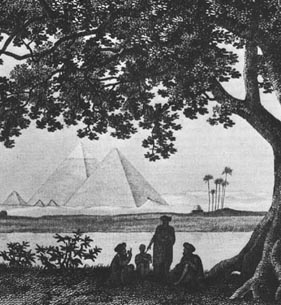
Drawing © 1971 Peter Tompkins.
September 25, 2002 Boston, Massachusetts - In ancient Egyptian cosmology, after the moment of death there came existence in the afterlife where joys of earthly existence were duplicated. One of the "machines" to get to that heaven was the Great Pyramid of Cheops built 4,500 years ago for King Khu-fu in the 4th Dynasty on the Giza plateau near Cairo. Some have called the pyramid a launching pad for the King's "ka," or soul, to travel to the circumpolar stars in the north, known as the "imperishable ones," and to the star Sirius and Orion constellation in the south where Osiris, King of the Dead, reigned eternal. In a paradoxical way, the Egyptians thought that whatever worked in this life would not work in the afterlife. So, in the burial chambers of noblemen, they carved doors out of stone with locks that no human could use, but the ka of the dead could move into and through the symbolic stone doors in a kind of Alice In Wonderland way to activate life in the opposite hereafter.
Click here to subscribe and get instant access to read this report.
Click here to check your existing subscription status.
Existing members, login below:
© 1998 - 2024 by Linda Moulton Howe.
All Rights Reserved.

